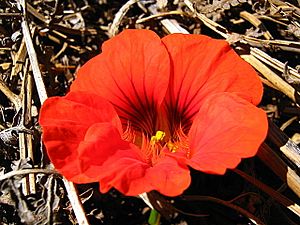Tropaeolum facts for kids
Quick facts for kids Tropaeolum |
|
|---|---|
 |
|
| Tropaeolum majus | |
| Scientific classification | |
| Kingdom: | |
| (unranked): | |
| (unranked): | |
| (unranked): | |
| Order: | |
| Family: |
Tropaeolaceae
|
| Genus: |
Tropaeolum
|
| Species | |
|
About 80 species. |
|
Tropaeolum is a group of about 80 different kinds of plants. These plants can be either annuals (meaning they live for one year) or perennials (meaning they live for more than two years). They are herbaceous plants, which means they have soft, green stems instead of woody ones. All Tropaeolum plants are flowering plants and are the only type of plant in their family, called Tropaeolaceae.
These interesting plants originally come from Central America and South America. One special kind, called Tropaeolum polyphyllum, grows in Chile. Its roots can stay alive underground even when the air gets super cold, down to -15°C (5°F)!
Contents
What are Tropaeolum Plants?
Many people know Tropaeolum plants by their common name, nasturtiums. These plants are famous for their bright, colorful flowers and unique, round leaves. The leaves often look like small shields. Nasturtiums are easy to grow and are a favorite in many gardens around the world.
Flowers and Leaves
Nasturtium flowers come in many colors, like yellow, orange, red, and even cream. They often have a spicy, peppery taste. The flowers have a special shape, almost like a trumpet, with a little "spur" at the back. This spur holds nectar, which attracts pollinators like hummingbirds.
The leaves are usually round and flat, with the stem attached in the middle, like an umbrella. Water often beads up on the leaves, which looks really cool after it rains. Both the flowers and leaves are edible, meaning you can eat them!
Where Tropaeolum Grows
Tropaeolum plants are native to the warmer parts of the Americas. They grow naturally in places like the Andes Mountains in South America. Some types, like the one from Chile, are very tough and can handle cold weather.
Many varieties of nasturtiums are now grown all over the world. People plant them in gardens, hanging baskets, and even as ground cover. They are popular because they are beautiful and relatively easy to care for.
Uses of Tropaeolum
Nasturtiums have been used for a long time for different purposes.
Edible Uses
One of the most exciting things about nasturtiums is that they are completely edible!
- Leaves: The leaves have a peppery, slightly spicy taste, similar to watercress. They are great in salads or as a garnish.
- Flowers: The colorful flowers also have a peppery flavor. They add a beautiful touch to salads, sandwiches, or even desserts.
- Seeds: The young, green seeds can be pickled and used like capers.
Medicinal Uses
Historically, some cultures have used nasturtiums for their possible health benefits. They contain Vitamin C and other compounds that might help with minor illnesses. However, it's important to remember that plants used for medicine should always be discussed with an adult or doctor.
Garden Uses
Nasturtiums are also popular in gardens for other reasons:
- Ornamental: Their bright flowers make any garden look cheerful.
- Companion planting: Some gardeners plant nasturtiums near other vegetables. They believe nasturtiums can help protect other plants from certain pests by attracting the pests to themselves.
Life Cycle of Tropaeolum
The life cycle of Tropaeolum plants depends on whether they are annuals or perennials.
Annual Nasturtiums
Annual nasturtiums complete their entire life cycle in one growing season.
- They grow from a seed in the spring.
- They produce leaves and then beautiful flowers.
- After flowering, they produce seeds.
- The plant then dies, but its seeds can grow into new plants the next year.
Perennial Nasturtiums
Perennial nasturtiums live for more than two years.
- They grow from seeds or from underground roots (like tubers).
- They produce leaves and flowers each year.
- When winter comes, the top part of the plant might die back, but the roots stay alive underground.
- New growth appears from the roots in the spring, allowing the plant to return year after year.
Images for kids
See also
 In Spanish: Tropaeolum para niños
In Spanish: Tropaeolum para niños







